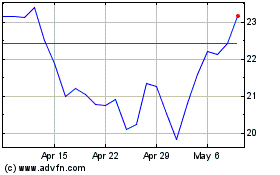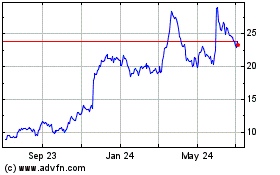By Saabira Chaudhuri
Shoppers are buying more clothes and discarding them faster than
ever, a trend that is sending an increasing amount of textiles to
the dump and propelling the fashion industry to search for new
technology to recycle used garments.
The growth of fast-fashion retailers like Hennes & Mauritz
AB, Inditex SA's Zara and Gap Inc. -- each vying to deliver quicker
and cheaper styles -- has flooded the world with affordable
clothing that is worn just a few times.
Globally, the number of garments purchased annually by the
average consumer jumped 60% from 2000 to 2014, according to
McKinsey &Co., and the number of times an item is worn before
it is discarded dropped 36% between 2002 and 2016, the Ellen
MacArthur Foundation, a U.K.-based nonprofit organization focused
on cutting waste says. In the U.S., clothes are worn for around a
quarter of the global average.
Despite the buildup of used clothes, the technology to recycle
old textiles into fiber to make new ones has remained embryonic,
meaning clothes eventually end up in the dump or incinerator.
Textiles in American landfills jumped 67.7% by weight from 2000 to
2015, according to the U.S. Environmental Protection Agency.
So far, companies have focused on improving collection of used
clothes. H&M and Zara are rolling out in-store bins to collect
garments which are then sold as secondhand clothing, largely to
emerging markets, or turned into other products.
But some countries, like Rwanda, have raised taxes on secondhand
clothing imports to help domestic-textile production, which has
floundered in the wake of a flood of used clothing from countries
like the U.S.
There has been little regulatory pressure on clothing makers to
take responsibility for the waste generated by their products,
unlike the crackdown seen in other areas, such as single-use
plastics. France is the only country to hold textile producers
responsible for recycling or disposal. The U.K. is considering
similar rules.
Garments that are recycled are mostly turned into lower-value
products like wiping cloths and insulation, which ultimately hit
the landfill. Clothing that does include recycled material
typically uses plastic bottles rather than old textiles.
Less than 1% of the fiber used to produce clothes is recycled
into new garments, the Ellen MacArthur Foundation says. Part of the
challenge of using old clothes to make new ones is that most
clothing contains a blend of materials, like cotton and polyester,
which are difficult to separate.
The environmental impact of clothing is set to keep growing.
Global consumption of apparel and footwear is estimated to rise 63%
between 2015 and 2030 to 102 million tons, according to Boston
Consulting Group. Studies show the growing popularity of synthetic
clothing like fleece jackets and gym leggings is also releasing
more tiny plastic particles into the ocean when the garments are
washed.
Apparel companies say they are trying to find ways to turn old
clothing into new, motivated by the threat of resource constraints
and growing concern among consumers about the environmental impact
of their buying behavior.
"We know resources will get more and more scarce," said Cecilia
Brännsten, H&M's environmental sustainability manager. "With
climate change there's more and more pressure on land use so we
know we will have to turn to recycled material."
The H&M Foundation -- a nonprofit funded by the retailer's
founding Persson family -- is exploring ways to make clothing from
existing fiber rather than using new plastic, used to make the
majority of clothes, or cotton.
Proponents of so-called closed-loop recycling say making new
clothes from old would reduce greenhouse-gas emissions and the
consumption of oil, which is used to make synthetic fibers;
fertilizers and water, used to grow cotton; and chemicals used to
produce, dye and finish fibers.
The H&M Foundation recently opened a pilot textile recycling
plant in Hong Kong that uses chemical and hydrothermal technology
to recycle cotton and polyester blends into new yarns. Polyester is
recovered in fiber form, which can be respun. Recovered cotton
breaks down into a cellulose powder, but the organization is still
looking for a way to use this. It says the technology will be
available for the industry to use, potentially next year.
Inditex is funding textile recycling research by the
Massachusetts Institute of Technology and says by next year it will
have invested $3.5 million in closed-loop technology. It is also
working with Lenzing, an Austrian producer of plant-based textiles,
to make new fiber from its cotton waste.
Before clothing can be recycled it must be sorted. A group of
European companies is developing a system called Fibersort that can
automatically separate large volumes of garments by fiber. Clothes
made of a single material are identified using scanners and then
sorted, so they can eventually be made into new garments.
While efforts to recycle old clothes into new are still nascent,
Americans are increasingly shopping for secondhand clothing.
Companies say that is driven by consumer desire to save money, help
the environment and avoid appearing in the same clothes twice on
social media platforms like Instagram.
J.C. Penney and Macy's Inc. in August said they would start
selling secondhand clothing from online marketplace thredUp Inc.
Thredup says the U.S. resale market has grown 21 times faster than
the overall retail apparel market over the past three years. J.C.
Penney Chief Executive Jill Soltau told investors there were "more
secondhand shoppers than ever before" citing "an emotional thrill
that comes with finding a high-quality secondhand product for much
less."
Write to Saabira Chaudhuri at saabira.chaudhuri@wsj.com
(END) Dow Jones Newswires
October 02, 2019 05:44 ET (09:44 GMT)
Copyright (c) 2019 Dow Jones & Company, Inc.
Gap (NYSE:GPS)
Historical Stock Chart
From Apr 2024 to May 2024

Gap (NYSE:GPS)
Historical Stock Chart
From May 2023 to May 2024
